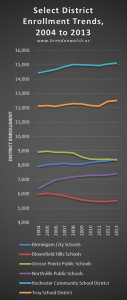If Assistant Superintendent Chris Fenton’s projections for the 2015-16 school year come to pass, the Grosse Pointe Public School System’s General Education student enrollment will fall to its lowest level since 1993.
That date is significant as it preceded the state’s landmark school funding overhaul, 1995’s Proposal A, among whose most significant characteristics is that district revenue is tied directly to student enrollment.
The GPPSS enjoyed the ride since Proposal A’s passage. In 1993, the General Education student enrollment was 7,680. It rose steadily from that time hitting a high water mark of 8,930 in 2005. But it’s been all down since then, reaching 7,914 this year and then a projected drop to 7,760 next year.
That drop from 8,930 t0 7,760, if it were to come to pass, represents an annual revenue loss of nearly $12 million since the GPPSS receives about $10,000 per pupil in revenue.
The only good news about that kind of drop is that it has been gradual and the district’s response to that kind of revenue loss has generally been staff level reduction. Historically, teaching staff reduction has been roughly proportional to student enrollment. Non-teaching staff reduction has been much more steep.
It is true that the GPPSS enrollment reduction is directionally consistent with Michigan population, but not as bad. From 2004 to 2013, Michigan’s student population has dropped about 12% while the GPPSS has dropped just over 6%. This student population drop has been a statewide phenomenon and was one of the big drivers for the growth in School of Choice programs – as districts competed with each other for a more scarce resource – students.
The GPPSS famously has not, and will not, be a school choice participant, but that factor alone cannot completely account for its drop in enrollment in contrast to other similar districts.
As the chart on the left shows (please click to enlarge), among the GPPSS, Birmingham, Bloomfield Hills, Northville, Rochester and Troy Schools, Grosse Pointe and Bloomfield are the only two whose enrollment has dropped from 2004 to present.
I have highlighted the contrast to Birmingham before. In 2004, the GPPSS had 1,000 more students than Birmingham. Today Birmingham enrollment is greater than GPPSS. Birmingham has not relied on School of Choice to increase enrollment.
Bloomfield has been more like GPPSS, in fact far worse. Within the last few years, after a protracted and divisive battle, Bloomfield closed one of its two high schools.
This is the kind of issue that requires a great deal of analysis – and probably more than the district has undertaken. But at least among the statewide data and in contrast to Bloomfield and Birmingham Schools, we cannot fairly pin the GPPSS’ enrollment drop on any one thing – and probably not even on just the school system itself.
Yes, great schools can and do attract families. But of course the schools in Bloomfield are outstanding – and I generally think GPPSS are very good schools. Birmingham and Northville are examples of communities that are solving this riddle. The Grosse Pointes have some work to do.

5 responses to “GPPSS projects significant enrollment drop”
When are we going to admit to ourselves that there’s a problem in our community? We need to address the horrible demographics of GP. We need more young families to move here and we need to salvage the North end.
GP for Life,
I agree. This is a discussion we need to start having. I need a better look at the data beyond just the school enrollment, but it’s a series of trends that ultimately are not good for the communities. Thanks for reading.
Brendan
As a young person who recently moved to GP, I definitely think the community needs to address several internal issues to get young people moving here.
The main reasons I hear from peers as to why they choose areas like Birmingham, Berkeley, Pleasant Ridge are:
1. The more affordable first time buyer starter homes are typically a stones throw of Mack and therefore some bad areas of Detroit. The horror stories on the news of car theft and home invasion, while still rare, are perceived as a problem in these areas.
2. Lack of entertainment. While the addition of Atwater in the Park is a step in the right direction, the village and the hill have very little to offer in terms of bars + dining that are appealing to those under 35. Maybe instead of adding big box chains like Pet Supplies Plus to the Village, some trendier restaurants could be brought in.
3. Non-centric location. For those employed in Detroit, I’d argue GP is the best spot in terms of commute. But working anywhere else in Metro Detroit.. not so much.
[…] week I published a blog that again pointed to the ongoing problem the Grosse Pointe Public School System faces in student […]
Location, location, location. Here in the GPs, at times, it seems as if we are between a loch and a hard place. A very interesting and very fortunate bubble. My main concern with the district is the limited opportunities for students who are not college-bound. After a planning opportunity of almost 10 years, 2016 is the year when many Michigan high school students will be required to have two consecutive years of a language other than English in order to graduate from high school. In Grosse Pointe, we do not separate our AP track from our Non-AP track until level IV. When I compare our World Language curriculum to a standard’s based curriculum I fear we are disenfranchising a significant number of our students.